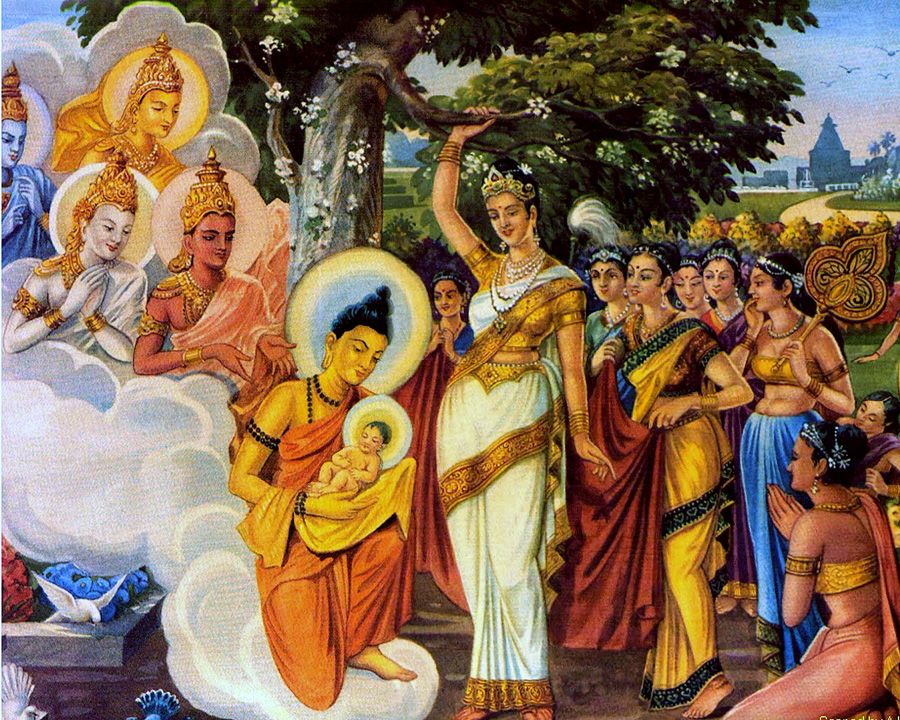There are many varieties of Buddhism, many threads of that teaching, that emerged after the appearance of the historical figure that is known in these times as “the Buddha.” This lecture is not about any of those schools, movements, or religions popularly recognized as “Buddhist.” Instead, this lecture is about the source from which Buddhism originally emerged.
Buddhism—like many other “-isms” in the world—first appeared to humanity in the form of advice from a highly developed human being, advice intended as practical instruction for those who want to likewise become highly developed. The man who gave this advice was a human being like any other, yet with a critical difference: he awakened his consciousness.
The awakening of the consciousness is the very purpose of life. It is for this cause that every prophet, avatar, angel, buddha, master—or whatever you call them—ever appeared to humanity. From their lips emerged all of the world’s religions, and all with the purpose of indicating to those who sleep (such as you and me) that we need to awaken.
Reality is elusive, incomprehensible, and imperceptible to those who remain at the stage of the embryo. How can the seed understand the sun, moon, and stars, if it remains enclosed in its shell, dreaming the dreams of a seed?
To awaken is not a matter of heritage, race, inheritence, or belief. Any seed can break free from the shell and become that which it was made to become—but to break free requires specific steps, exact science, and an unswerving will.
Thus, to address the variety of needs of humankind (the embryos of real human beings), compassionate caretakers—who awakened their consciousness and became real, fully developed human beings—appear from time to time to remind us of the purpose of life. The man called “the Buddha” was one, as were Jesus, Moses, Abraham, Krishna, Quetzalcoatl, and many, many others.
From this perspective, we can begin to grasp that the similarities among religions indicate their common source, which is accessible relative to the degree we have awakened our own consciousness. (To understand their many differences, we only need to look to the greed, ignorance, and foolishness in our own minds, and recall that it is men who have corrupted their religions, turning them into vehicles of profit and power.)
Every religion contains great beauty and wisdom. Yet, at this time, none are perfect. Buddhism—in all its forms—represents a teaching of tremendous insight and transformative potential. Yet, it is not complete, and even the Buddha himself said so. What we know as “Buddhism” is but a small stream that emerged from a vast ocean.
Those who are scholars of Buddhism or who are well versed in one school of Buddhism or another will discover much in this book that will be unfamiliar to them. It is important for them to remember one of the central facets of the Buddha’s original teaching: the student should always keep his bowl turned upright and empty. In other words, the mind should remain receptive, empty, with the ability to receive new information and new understanding.
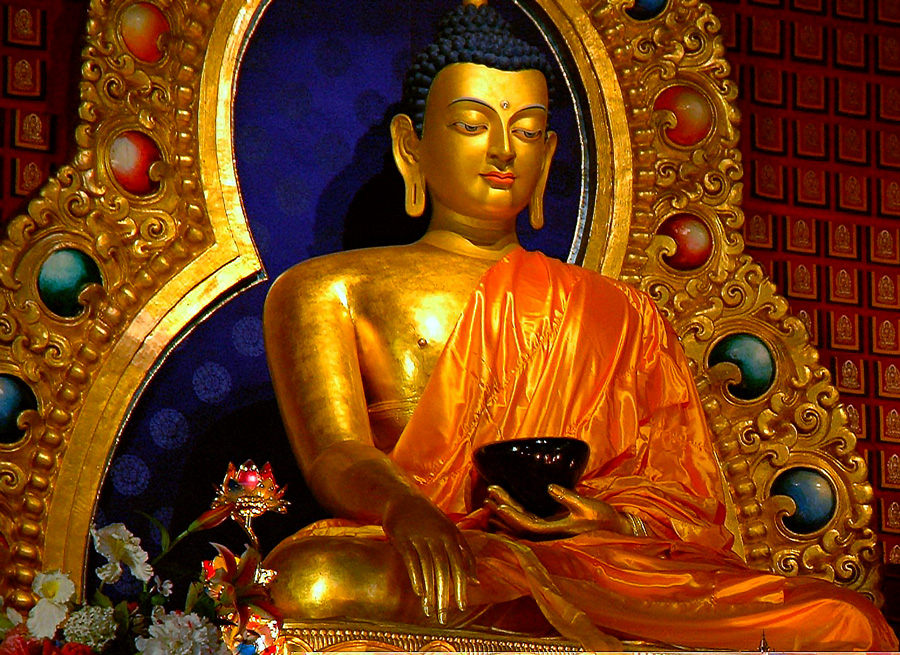
The Bowl Respresents the Mind
The fool who knows his foolishness, is wise at least so far. But a fool who thinks himself wise, he is called a fool indeed. - Dhammapada 5:63
Those who have their bowl—their mind—full of information are like those who suffer from constipation. And those who have their bowl upside down—with the mind closed—are starving themselves to death. Therefore, it is for our own benefit to empty our mind of preconceived notions, and remain in the present moment, ready to gratefully receive that which is new. There is much that Buddhists can teach to the world—yet there is also much that Buddhists can learn from other traditions.
This book presents an understanding of the lifestory of the Buddha that differs markedly from common or mainstream beliefs, yet is harmonious with the root teachings. Through the teachings presented here, the patient and open-minded reader will discover a doorway to a vast and wondrous knowledge. The expert, the bookworm, the believer, whose mind is closed, stale, and stagnant, will not. Such a person will remain as they are.
Gnosis: Conscious Knowledge
In a lecture entitled The Esoteric Path, the great Gnostic teacher Samael Aun Weor said:
“Unquestionably, the two greatest leaders of all time are Buddha Shakyamuni and Jesus Christ.”
These two men founded two of the world’s greatest religions: Buddhism and Christianity, respectively.
It is important to recognize that both of these phrases—“Jesus Christ” and “Buddha Shakyamuni”—are titles: they are not personal names. These are not names given at birth; these are titles that are earned. These titles reflect degrees of conscious development.
- Jesus: derived from an Aramaic (ancient Hebrew) word, Yeshua, which means “savior.” Thus, the original use of this term is as an honorific title, such as “rabbi.”
- Christ: from the Greek Christos, “the Anointed One,” and Krestos, whose esoteric meaning is “fire.” Christ is not a person, but an energy, a force, an intelligence. Christ is also known as Avalokitesvara, Chenresig, Vishnu, Quetzalcoatl, and more.
- Buddha: Literally, “awakened one.” Every intelligence in the superior worlds is a buddha, each at is own level.
- Shakyamuni: Usually translated as “sage of the Shakya clan.”
Regarding the symbolic nature of these titles and the teachings that correspond to them, Samael Aun Weor said the following:
On a certain occasion, I had to present myself in a Buddhist monastery in Japan; I had the occasion of speaking on behalf of Christ. Since it was a Buddhist and not a Christian temple, and due to my approach, a certain scandal arose amongst the Buddhist brethren, and therefore a complaint was presented to the Master, who approached me and interrogated me as follows:
“Why did you speak on behalf of Christ, knowing that this is a Buddhist monastery?”
“With the most profound respect to this sacred institution, I have to emphatically affirm that Buddha and Christ complement each other.”
I was expecting a response from the Master’s point of view, yet with great amazement, I witnessed his agreement; he said, “Indeed, Buddha and Christ complement each other; this is how it is…”
Then, he asked for a thread or cord, and when they brought it to him, he told me, “Show me your right hand.”
When I showed him my right hand, he tied the thread on my thumb. Thereafter, he tied the same thread on the thumb on my left hand, and ended by saying in a Zen way: “Buddha and Christ complement each other…”
Then, I left that monastery, having perfectly understood the Koan. In the name of the truth, we have to recognize that this is a very wise Koan: Buddha and Christ are joined within us, because the right thumb represents the Christ and the left represents the Buddha: the two of them are two factors within us. - Excerpted from a lecture entitled The Esoteric Path by Samael Aun Weor
Clearly, this is a kind of Koan, a kind of esoteric riddle. The meaning is that we have many parts, we have many aspects, each of which has its function and its place, and when united they harmonize and form a whole. In that sense, Buddha and Christ are two parts of one perfected thing, which is our own consciousness.
The abbot of that temple understood this. He understood that the true Dharma—the true religion—is universal. He understood that at their base every religion is derived from the one religion. Where we find sectarianism and doctrinal dispute, we find misunderstandings of the teaching itself, because in truth, religion is one. Buddha and Christ, in their base, are complements of one another. And yet, they are distinct.
Buddhism and Christianity are streams of wisdom that emerged from the same ocean of knowledge. We call this ocean Gnosis. Gnosis is a Greek word that means “knowledge.” Gnosis is the root wisdom of all the world’s religions. Gnosis is objective, pure, universal, absolute, conscious wisdom. Gnosis is beyond time and space, beyond culture, beyond history. Gnosis is the knowledge acquired by those who awaken their consciousness. Among such persons, there is no conflict or disagreement. Truth simply is.
Once the Buddha was walking with some monks in the Simsapa forest. The Buddha took up a few simsapa leaves in his hand and asked the monks, “Which is more: the few leaves in my hand or those in the forest?”
The bhikkhus replied, “The leaves in your hand are few, but those in the forest are more and numerous.”
Then the Buddha said, “So too, monks, the things I have directly known but have not taught you are numerous, while the things I have taught you are few, like these leaves in my hand.”
Real Dharma—Gnosis, knowledge from awakening—encompasses all the leaves of the forest.
What is a Buddha?
The term “Buddha” is a title. It is an ancient term, which means “Awakened One.” Now, in these times we typically talk about “the Buddha,” which in the exoteric point of view, the common point of view, refers to one particular person, who is also known as Buddha Shakyamuni, or Gautama. But in truth, the name Buddha is a title, in the same way that Christ is a title. Christ is that universal energy at the base of all things, the force that gives life to all existence (this force has many names in Buddhist schools; examples include Chenresig, Avalokitesvara, Bodhichitta). The word Christ is also a title for any person, any being, who incarnates that sublime energy, who merges and becomes one with that energy, who expresses it. So, a Buddha is someone who has incarnated his own Inner Buddha, in other words, his own Inner Spirit, who is awake. In the Kabbalah, this refers to Chesed, our own Spirit. A Christ is someone who has gone beyond that level, and become something more.
In reality, there are many different kinds of Buddhas, because again, the term Buddha means “Awakened One.” We awaken according to specific levels. The consciousness awakens by degrees, according to our work. So, when someone is given the title Buddha, it doesn’t mean that they enter into a level in which all Buddhas are the same. There are many levels of development.
When the title “Buddha” is first acquired by the Inner Spirit, the Innermost, it is just the first level. If you have studied Gnosis, you know that this is related to the initiation of Netzach and the creation of the Mental Body. When an initiate has completed the initiation of Netzach [the Fourth Initiation of Major Mysteries], his Innermost is called Buddha; his Innermost, his inner Spirit, becomes a Buddha: but a Buddha of that level. And from there, that initiate has to continue to work, to comprehend the mind more deeply and thereby ascend through different levels of Buddhahood, to acquire greater and greater understanding. In other words, within every initiate who is truly walking upon the path to complete awakening, there is an Innermost Buddha, and that Buddha awaits the moment when he can incarnate within his terrestrial vehicle (the physical person). This supreme accomplishment requires a great deal of work.
So, from this point of view, we can understand that there are actually millions of Buddhas. Really, every star is the expression of a Buddha, every star in the sky.

There are Innumerable Buddhas!
In the Gnostic tradition, we talk about two primary forms or types of Buddhas.
First is a Contemplation Buddha, which is really what we are talking about when we say Buddha itself, an Awakened One, or the Spirit. In classical Hinduism, this would be called Atman, or in Kabbalah, Chesed. This is our Inner Spirit. Our Inner Spirit becomes a Contemplation Buddha when the acquisition of that initiation occurs.
Second, there is the Manifestation Buddha. This is the vehicle through which the Contemplation Buddha will express himself. In Mahayana Buddhism, this would be called a Bodhisattva. So, the Manifestation Buddha is the awakened expression of the Contemplation Buddha.
When we discuss the historical Buddha, the Buddha Shakyamuni, we have to bear this distinction in mind. The historical Buddha—the physical person—was a Manifestation Buddha. He was a being who acquired a great deal of insight, who taught the Dharma, but he did that as an expression of his own inner Contemplation Buddha. His inner Being, the source of that light that expressed itself through Gautama, through Shakyamuni, is called Amitabha. If you have studied any traditional Buddhism you know that Amitabha Buddha (Amida) is widely worshipped, respected, and prayed to, especially in Japanese culture. Amitabha Buddha is seen as a Buddha of serenity and compassion, who has promised to liberate souls who call upon him. So, Amitabha expressed himself into the physical world through his vehicle—through his human soul, through his Manifestation Buddha—who was Gautama Shakyamuni.
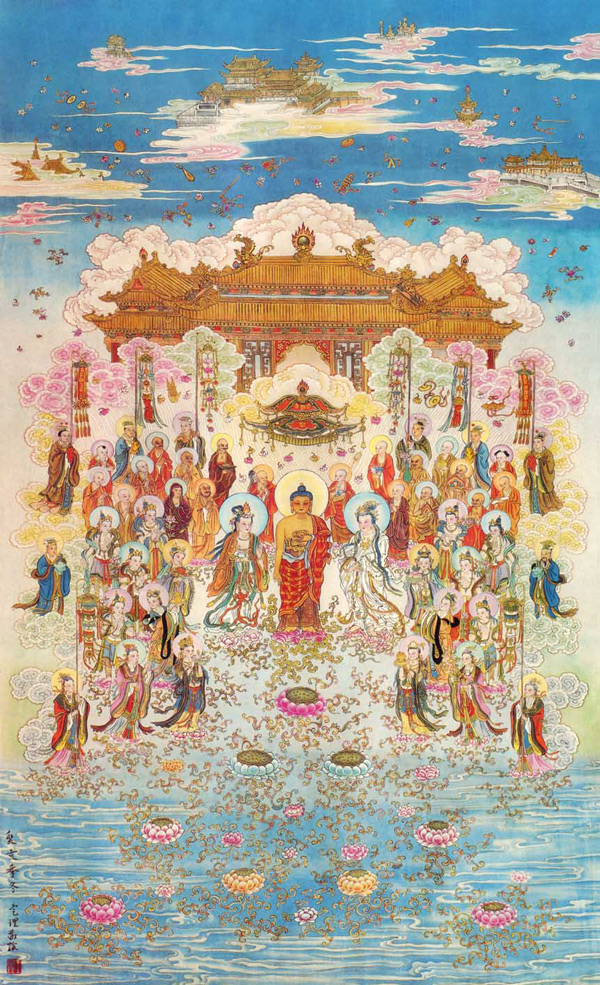
Amitabha in Heaven
We can relate this to the Christian scriptures, when we look at what St. Paul wrote about our inner constitution. In his terminology, the Contemplation Buddha is the spiritual body or Heavenly Man (Soma Pneumatikon), and the Manifestation Buddha would be his the earthy body or Human Soul (Soma Psuchikon), the Bodhisattva, the terrestrial man.
Paul states in Corinthians 15:44-49:
It is sown a natural body (Soma Psuchikon - Psychic body – “Soul-Image Body”); it is raised a spiritual body (Soma Pneumatikon –“Spirit-Image Body”). There is a Soul-Image Body, and there is a Spirit-Image Body. And so it is written, The first man Adam was made a living soul; the last Adam was made a quickening spirit. Howbeit that was not first which is Spiritual, but that which is Psychic; and afterward that which is spiritual. The first man is of the earth, earthy: the second man is the Lord from heaven. As is the earthy, such are they also that are earthy: and as is the heavenly, such are they also that are heavenly (the Pneuma). And as we have borne the image of the earthy, we shall also bear the image of the heavenly.
Now, even with this distinction of Contemplation and Manifestation, there are other important aspects to understand about this term “Buddha.” To acquire Buddha-hood is a matter of personal, in depth work. But there are stages of that work, there are levels, just like in life, when we achieve something. We may achieve something on a temporary basis or on a permanent basis. In other words, we could say that there are those who are permanently or firmly established in the state of Buddhahood, and there are those who achieve it in a transitory way, in a temporary way.
Difficult to obtain is the conception of men,
Difficult is the life of mortals,
Difficult is the hearing of the True Law,
Difficult is the birth of the Awakened. - Dhammapada 14:182
The Buddha Nature
The 14th Dalai Lama has repeatedly pointed out a very important aspect of the historical Buddha: at one time, the Buddha Shakyamuni was just like us. Buddha Shakyamuni is not seen as a God, or as a deity, who has always existed up in Heaven. In other words, the historical Buddha was a person, a human being, but because of his observation of the truth of life, the facts of life, he delved deeper and deeper into comprehending that truth. Because of that, he developed a great deal of wisdom, and due to that effort became an Awakened One. In other words, he completely awakened his consciousness and was able to directly perceive the Truth. So, he became a Buddha. But this is not something given by divine right, nor is it something that he acquired by belief, or by heritage, or patrimony, or some kind of gift, or a boon from the Gods; he acquired the state of Buddhahood through work. That is really the fundamental basis of his teaching: any person can become a Buddha. Anyone. And the cause, the reason, the source of that, is within you.
“The Buddha appears in the world so that sentient beings may obtain the gnosis that he himself obtained. Thus, the Buddha’s demonstrations of the path are strictly means to lead sentient beings to buddhahood.” - Introduction to the Kalachakra by the 14th Dalai Lama
The element within that gives us the potential to become a Buddha is called Buddha-nature. Buddha-nature in Sanskrit is Tathagatagarbha, or “the embryo of the Buddha,” the seed of the Buddha. In Zen and other Mahayana schools, they call it the Buddhata or Buddhadatu, which means “essence of the Buddha.” In Gnosis, we call it the “Essence.” By whatever name, it is the little seed of free consciousness that we have. As a seed, it is small, and it needs to be developed. It is not developed with beliefs, it is not developed with gifts, or “just because,” or by any natural law, like evolution. The Buddha-nature only grows and emerges by working with it: by awakening. This is simply because of Karma: cause and effect.
Any Buddha is a child of his own deeds. Any Buddha has grown that Buddha-nature into a tree, into wisdom. And this is done through a process of self-inspection, self-reflection, self-analysis. Such growth cannot occur through merely the intellect or beliefs, but only by utilizing the Buddha-nature itself, which is consciousness. So, obviously, the first thing that an aspirant towards Buddhahood has to know is what the Buddha-nature is and how one uses it.
If you remain in the dark about your own Buddha-nature, how to taste it, to experience it, to utilize it, then you are not on the path. It is very simple. In order to enter into the path towards becoming an awakened being, a Buddha, you have to work with that Buddha-nature, thus you have to know what it is. In order to awaken, you have to know what to awaken, and how to do it.
The Buddha-nature is your consciousness. To work with it is to make the effort to awaken it from moment to moment. This is done by using the consciousness actively, attentively, by directed will. One who does this always remembers they are in the body. One who does this does not daydream. Such a person is not distracted by internal or external phenomena. One who makes this effort pays attention to what they are doing, thinking, and feeling, and maintains continual cognizance of themselves. By this, they exert conscious will over their every action, and begin to turn back the tide of bad habits, wrong thoughts, harmful emotions, and all the causes of pain.
Buddha Shakyamuni summed up his entire teaching in one sentence. He said,
“I teach about suffering and the way to end it.”
In its essence, this is the method of working with the Buddha-nature. The method is to comprehend our own suffering and to end it. This is the very heart of Gnosis.
Not to commit any sin,
to do good,
and to purify one’s mind,
that is the teaching of the Awakened. - Dhammapada 14:183
The Buddha’s Teaching
Among the many traditions that sprang up in the wake of Buddha Shakyamuni, there are many variations. For some 2,500 years, these schools have been in conflict with one another over exactly what he taught. It is even difficult to pinpoint his precise date of birth, or the precise literal aspects of his life story. Part of the reason is that nothing of his teachings was written down during his lifetime—and nothing would be written for five hundred years. Five hundred years is a long time!
For five hundred years after his birth and subsequent death, none of his tradition was written, none of it was preserved, except through the oral tradition. And that tradition was very dispersed: it branched out all over India, spread all over Asia, and had many variations—because you know how an oral tradition can be. If you tell something to your friend, your friend will tell it to someone else in a little bit different way. Even among disciples of a person like the Buddha, disciples who are working with the consciousness, each will have their own idiosyncrasy, their own level, so will explain that teaching in a different way, according to their own level of understanding and their own interests. Gradually, over the period of five hundred years, the history, the story, and the teaching changed dramatically. In fact, Samael Aun Weor stated:
“Gautama the Buddha very wisely taught his doctrine, but his doctrine was very much adulterated by his followers.”
In fact, the Buddha himself predicted that would happen. In the written sutras, which began to be written down five hundred years after his death, it is recorded that the Buddha stated that within five hundred years of his death, his teaching would be so adulterated that it would be unrecognizable. So keep that in mind as you recall what you have been taught about Buddhism previously.
The Life of Buddha Shakayamuni
The life story of Buddha Shakyamuni is just a symbol; it is just the shadow of what really happened. Just like the other great teachers, such as Jesus, Krishna, or Moses, we have the form of a life story, but in reality it is a symbolic story, an initiatic story, which has been passed down in order to teach disciples about the path. So, the story of the life of Buddha is not a literal story. It may have elements of his literal life, in the same way that the Christian Gospels relate some elements of the physical life of Jesus, but they do not tell his actual physical life: they tell an initiatic representation of that life, and are a teaching story.
Nonetheless, historically, it is understood that the historical Buddha was born more or less five hundred years before Jesus (500 to 600 BC), about twenty five hundred years ago. He was born in what is now known as Nepal. His name, Gautama, was his family name, and Shakyamuni came from Shakya, the name of his tribe, his clan. It is an ethnic group who still exist in Nepal. Shakya means “lion.” The name Gautama has a certain relationship to “cowherd.”
The many traditions of Buddhism relate his life story in different ways. Buddhism does not present itself in the same fashion as many of the western religions. Where the western religions have somewhat established scripture that they consider to be authoritative, in Buddhism there is more diversity. For example, Christianity relies upon the Bible (the Old Testament and the New Testament): all the books that are gathered into that collection were agreed upon as essential and authoritative by scholars and leaders in the preceding centuries. They picked them based on dogmatic and political causes. But in Buddhism, there is a huge variety of schools spread all over Asia, and every one of these schools has their own approach to the scriptures, and has their own scriptures that they believe are more authoritative. And, of course, amongst these schools, the scriptures all disagree with each other, because they are all derived from the oral tradition. There is very little in terms of written documentation from the early years. It was only later, gradually, over time, that more and more was written down.
In this book, the story of the Buddha Shakyamuni is derived primarily from Tibetan versions. Yet, even among the Tibetan versions, there are what you might call disparities or contradictions. Once again, remember: these are not literal stories. These stories are told in order to explain the teaching.
In Tibetan culture, the Buddha Shakyamuni is the key figure upon which their entire culture is based. His life story is traditionally taught and represented in a series of twelve steps. These are called different things, but you can say they are the “twelve great deeds” or the “twelve great works” of the Buddha. You might see Tibetan paintings or thangkas that represent the stages of the life of Buddha, with twelve primary points of focus.
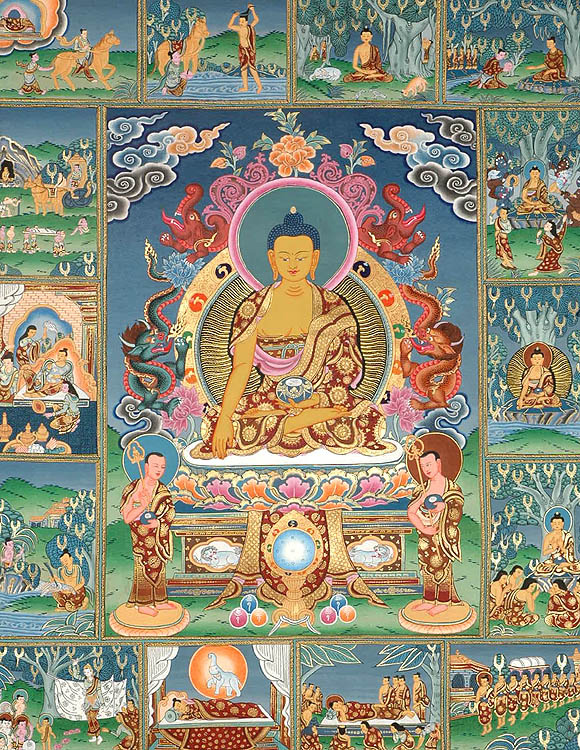
The Twelve Stages of the Life of Buddha Shakyamuni
The number 12 is a very significant number in all religions and mythologies. To fully elaborate the importance and meaning of this number would fill volumes of books; but if our purpose is to demonstrate the universal source of all religions, we can compare the twelve stages of the Buddhas life with the first twelve arcana of the Tarot.
The Tarot
The origins of the Tarot are unknown to the populace. Mistaken as game cards or entertainment, the Tarot is actually a series of laws encoded in a visual form, whose meaning and importance can be discovered by anyone who meditates profoundly upon their symbols.
The Tarot is a visual, symbolic depiction of the science of numbers, which is also known as in Judaism as Kabbalah or in Buddhism as Kalachakra. Each of these traditions is based upon the same foundation: that all existence is mathematic and exact, being based upon unwavering laws. The most fundamental of these laws is the law of cause and effect, known in Sanskrit as karma.
In regards to the full development of the human consciousness, there is nothing vague or left to chance: everything is the outcome of precise action. The initiate who aspires to become fully awakened must comprehend with exactitude the path he intends to take. This path is encoded in the Tarot. However, the encoded information has little or no relationship with the Tarot as used by fortunetellers, card sharks, or weekend mystics.
Heretofore, the laws represented by each image of the Tarot have remained veiled from the eyes of the flesh, in the same way that the beams of a house are hidden. Yet, if you want to build your own house, you cannot do so merely by imitating the external appearance of a house: you need to know how to build the foundation and the internal architecture. This is equally true of the consciousness. Those who have abused the Tarot and cheapened it—much as has happened with Tantra—have unfortunately created an poor impression of a very deep and rich tool that can lead the sincere seeker into very elevated regions of the consciousness.
The Tarot—like Kabbalah or Kalachakra—symbolizes the inner architecture of existence. The Tarot is a series of seventy-eight glyphs: twenty-two Major Arcana and fifty-six Minor Arcana. Each one has correspondences to astrological, numerical, and magical values.
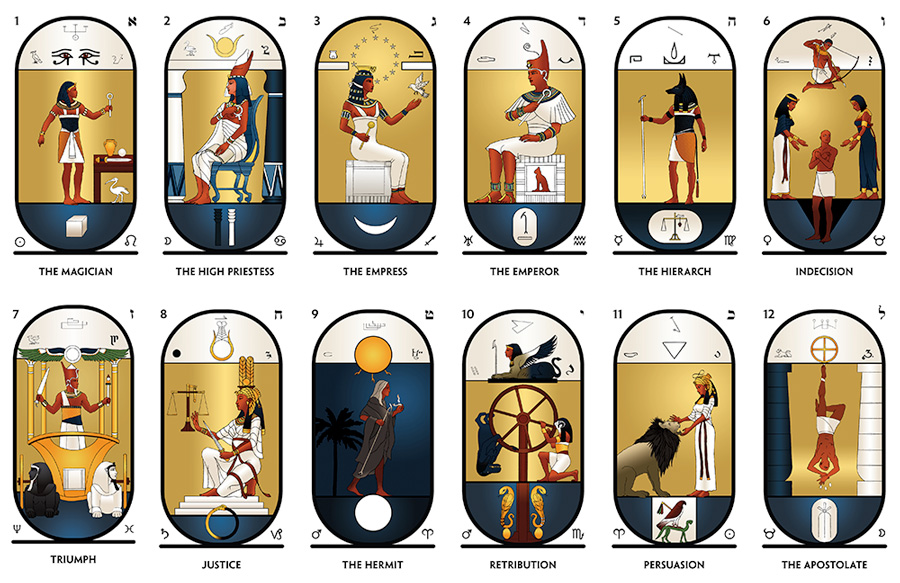
The First Twelve Arcana of the Tarot
These glyphs originate in the internal worlds. The popular Tarot decks found in shops have little or no relationship with the real Tarot as used in the higher levels of existence. In the Gnostic tradition, we rely upon a set of images [depicted in this book] that act as reflections or doorways to the genuine Tarot. Anyone who trains in meditation and develops insight (vipashyana or inner sight) can use these images as doors to investigate the real Tarot for themselves.
By analyzing the Tarot alongside the story of the Buddha Shakyamuni, we can see the inner architecture of every religion, and the very basis of the development of the consciousness. By analyzing the story of the Buddha deeply, we will see the universal symbols mirrored within it.
A full explanation of the sacred Tarot can be found in the writings of Samael Aun Weor, especially Tarot and Kabbalah and Alchemy and Kabbalah in the Tarot.
First Great Deed: The Promise
It is related in the Tibetan traditions that the Buddha Shakyamuni, before he received that title, was known by the name Shvetaketu (or alternatively as Devaputra), and that he was a great and enlightened Master in the heavens (in the superior dimensions) teaching the Dharma (spiritual wisdom) to the Gods. He had achieved this level through countless previous existences.
Shvetaketu, which means “White Banner,” was teaching in the Tushita Heaven. This is a realm of Nirvana, a superior level of existence, populated by Gods, or in other words, beings who had already achieved a certain degree of understanding; they had certain degrees of initiation. There are many levels of Beings, which correspond to the many levels of consciousness, and each being dwells in the realm that relates to his or her own level of consciousness.
This part of the story concerns the Contemplation Buddha—the Inner Buddha—who exists in a superior level of existence. He is the Magician symbolized in the Arcanum One of the Tarot.
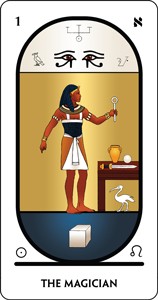
The number one, the Father who is in secret, is the Eternal Masculine Principle. He is within Himself Brahma, who has no form, is impersonal and ineffable, and who can be symbolized by the sun. - Samael Aun Weor, Tarot and Kabbalah
The word “magician” comes from an ancient word “mag,” which means priest. This is where the Bible derived the word “magi.” A true magician is a priest, not a trickster. In modern times, the word magician is misused.
A properly illustrated Tarot card has three sections. The uppermost section symbolizes the superior levels, or in this case, “heaven” or Nirvana. The Arcanum One—the first Tarot card, shown here —depicts the open eyes of the Inner Buddha, who looks down from the superior levels of existence. This is also a symbol of awakened consciousness.
Below, in the middle section, the Magician (symbolized by a Pharoah, the Egyptian equivilent of a Dalai Lama) points downward, because only by descending into manifestation can he develop the Buddha nature and likewise awaken consciousness completely. When we—the Buddha nature—accomplish this goal, we accomplish the purpose of life, which is to unify all the parts of the Inner Buddha, and create a fully developed human consciousness. Until that time, we are incomplete, and so is the One who is inside of us.
In the story, the Inner Buddha was teaching the Gods—what we can also call Devas, Angels, or Archangels—and was reminded of his promise to return once again to the physical world in order to teach human beings. Some time previously, he had promised to descend into the world at the time when it was most ripe, in a time when it was most needed.
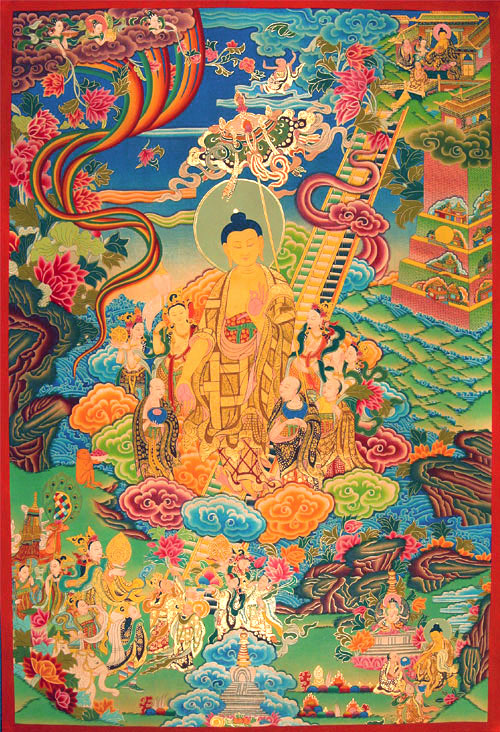
Shvetaketu Descending from Tushita to Help Relieve Suffering
The Kagyu tradition from Tibet relates that when Shvetaketu looked down on this physical world, he saw the suffering of humanity, and he considered whether it was time for him to descend to help them. The Gods encouraged him and said, “It is important for you to go teach the Dharma.” They said, “The world is in ruin because of the 6 dialecticians, the 6 followers, and the 6 meditators.” In other words, the world is in ruin because of “666.” If you have studied Christianity, you know the significance of this number.
And I beheld another beast coming up out of the earth; and he had two horns like a lamb, and he spake as a dragon.
And he exerciseth all the power of the first beast before him, and causeth the earth and them which dwell therein to worship the first beast, whose deadly wound was healed.
And he doeth great wonders, so that he maketh fire come down from heaven on the earth in the sight of men,
And deceiveth them that dwell on the earth by the means of those miracles which he had power to do in the sight of the beast; saying to them that dwell on the earth, that they should make an image to the beast, which had the wound by a sword, and did live.
And he had power to give life unto the image of the beast, that the image of the beast should both speak, and cause that as many as would not worship the image of the beast should be killed.
And he causeth all, both small and great, rich and poor, free and bond, to receive a mark in their right hand, or in their foreheads:
And that no man might buy or sell, save he that had the mark, or the name of the beast, or the number of his name.
Here is wisdom. Let him that hath understanding count the number of the beast: for it is the number of a man; and his number is Six hundred threescore and six (666). – Revelation 13:11-18
Christians in modern times read this passage literally and miss the symbolic significance of it, because to their misfortune they ignore that the Book of Revelation of St. John is a book of kabbalistic symbolism. But let us go deeper than the literal meaning, and discover the real meaning hidden in the symbol.
The Gods told the Buddha that the world is in ruin because of 6 dialecticians. What is a dialectician? It is someone who utilizes a dialectic, intellect, reasoning, or in other words, what the bible calls “scribes.”
Then spake Jesus to the multitude, and to his disciples, saying, The scribes (intellectuals) and the Pharisees sit in Moses’ seat: All therefore whatsoever they bid you observe, that observe and do; but do not ye after their works: for they say, and do not. – Matthew 23:1-3
But woe unto you, scribes and Pharisees, hypocrites! for ye shut up the kingdom of heaven against men: for ye neither go in yourselves, neither suffer ye them that are entering to go in. - Matthew 23:13
Woe unto you, scribes and Pharisees, hypocrites! for ye make clean the outside of the cup and of the platter, but within they are full of extortion and excess.
Thou blind Pharisee, cleanse first that which is within the cup and platter, that the outside of them may be clean also.
Woe unto you, scribes and Pharisees, hypocrites! for ye are like unto whited sepulchres, which indeed appear beautiful outward, but are within full of dead men’s bones, and of all uncleanness.
Even so ye also outwardly appear righteous unto men, but within ye are full of hypocrisy and iniquity. – Matthew 23:25-28
The Arcanum Six of the Tarot represents a soul caught in the snare of duality, which is exactly where intellectuals always get caught: between pro and con, for and against, thesis or antithesis.

The world is in ruin because of “6” intellectuals, or in other words, because of the Arcanum 6 and the psychological tendency to intellectualize the spiritual teachings: to just memorize the scriptures, or fill the head with many theories, to get caught in the debate and philosophy, but to stop there, and thereby fail to gain real experience of the Truth. Religions are filled with scribes: people who look like they know the teachings, and speak very well, and teach, and recite, but who are really just white tombs, as Jesus said, because they have no real development inside, spiritually and psychologically.
The Gods (the Angels, the Masters), said that the world is also in ruin because of 6 believers, in other words, what Jesus calls “Pharisees.” Those are people who love to look religious but are not, or who are very devoted to their tradition, but who lack any real development or experience of the Truth. We can call them “believers” because they often say that faith is all you need, to merely “believe.” Of course, we know that faith without works is dead, and by works is meant internal, spiritual, psychological works: the accomplishment of initiations in accordance with the awakening of the consciousness. Fanatics and those who merely believe do not enter into initiation, nor do they allow others to enter; instead they criticize, attack, and crucify the real initiates.
Believers are also caught in the snare of the Arcanum Six: to believe or not believe. Any belief is contradicted by another believe, thus believers always fight against other believers, because neither stands upon the ground of actual experience of that which they believe in.
The Gods said that the world is in ruin also because of 6 meditators, or those who believe that merely through willpower they can reach liberation from suffering. This includes people who practice all kinds of yogas or penances, yet who fail to work with the consciousness from moment to moment. This also includes all those who follow their traditions mechanically, who perform their rituals or observances, but without the consciousness awakened. In other words, they go to church or to the temple, but mechanically, with their consciousness asleep.
The disciples of Gotama (Buddha) are always well awake, and their thoughts day and night are always set on Buddha.
The disciples of Gotama are always well awake, and their thoughts day and night are always set on the law.
The disciples of Gotama are always well awake, and their thoughts day and night are always set on the church.
The disciples of Gotama are always well awake, and their thoughts day and night are always set on their body.
The disciples of Gotama are always well awake, and their mind day and night always delights in compassion.
The disciples of Gotama are always well awake, and their mind day and night always delights in meditation. - Dhammapada
In the Bible, in the Book of Revelation, the cause of suffering (the Antichrist, the great dragon) is identified as having the value of 666. In Gnosis, we study kabbalistic numerology very deeply, and the number 6 figures significantly both in the life of the Buddha and in the Bible. The Arcanum Six is the sixth card of the Tarot: the Arcanum of Indecision, which represents an initiate standing between two women: a virgin and a whore; in other words, two aspects of the Divine Mother, two aspects of Maya.
Any person like us is given the value of 666 because we are undefined: we stand between the virgin and the whore, psychologically speaking. In other words, we are trapped in the midst of illusion and have the necessity of choosing the virgin or the whore, truth or illusion, desire or liberation. This decision is made from moment to moment, and is determined by our actions. In each moment, we choose the Virgin or the Whore by our deeds. This choice is transformed into action through our three brains: intellect, emotion, and action.
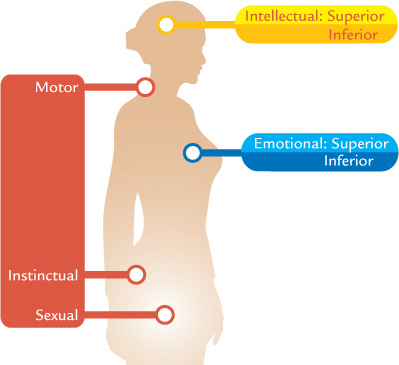
Our Three Brains
We are a 6 in our intellect because we are always caught in the duality between right and wrong, yes and no, black and white. The intellect—being trapped in the mechanism of duality—keeps us undefined, especially when we idolize and enthrone the intellect. Unfortunately, the intellect on its own cannot resolve it’s conflicts. This is illustrated by those who overdevelop the intellect and thereby lose contact with their heart, and fail to develop themselves in a balanced way.
We are a 6 in our heart (emotional brain) because we are always caught in the duality between pleasant and unpleasant feelings, between like and dislike, love and hate, anger and sweetness, etc. The emotional brain keeps us undefined especially when we idolize and enthrone our emotions, and fail to use reasoning to balance the desires of the heart. Those who are swept through life by surging emotions quickly become exhausted and sick in the heart.
We are a 6 in our body (motor-instinctual-sexual brain) because we are always caught in the duality between action and inaction, pleasant and unpleasant sensations, to do or not to do. We remain undefined in this brain especially because we are so identified with sensations, and none is more powerful than the sensations of sex. Because of our addiction to sexual sensation, we remain slaves of the Whore, and continue walking deeper into darkness.
So, when the Gods tell the Buddha that the world is in ruin because of the 666, they are saying the world is in ruin because of the ego: how the ego utilizes the intellect through being dialectician (through being too intellectual), through the heart by being a Pharisee (a fanatic, a mere believer without any real experience of the truth), or by being what they call a meditator (a fakir, someone who does a lot of practices, who is very adamant about their own tradition and their own religion, but is fanatic, attached, and lacking any conscious development).
In each of these examples, what we are seeing is a fundamental aspect of Gnostic psychology, which indicates that we all have a kind of psychological predisposition related to one of these three brains. Some of us are more intellectual by nature, some of us are more emotional, and some of us are more instinctive. The Gods told Buddha that the world is in ruin because of these three types of people. In the bible, this is called the Tower of Babel.
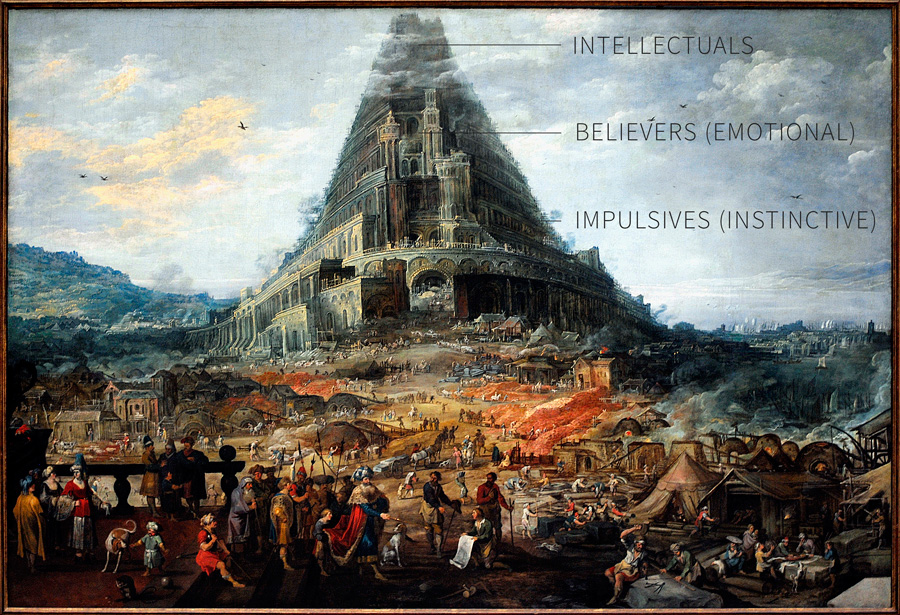
The Tower of Babel is Symbolic
These are the three inferior types of people. Whether we are more intellectual, more emotional, or more impulsive, so long as we are stuck in one of these three predispositions we are enslaved to the wheel of Samsara, and are dwellers of the Tower of Babel. Remember, the story of the tower is related to the confusion of tongues: the inability for different kinds of people to understand each other. The intellectual type (the scribe, the dialectician) cannot understand the believer (the Pharisee), therefore conflict ensues in our relationships, in our homes, and between nations. The man who wants to solve everything with his head will always be in conflict with the woman who always wants to solve everything emotionally—and vice versa.
The entirety of this situation—symbolized by the Biblical Tower of Babel—is also symbolized by the dragon of Revelation. The collective mind of humanity makes wonders, like cel phones, atomic bombs, movies, new technologies, new religions, and more, but instead of benefiting humanity, it is all serving to enforce the doctrine of the ego more and more: psychological enslavement to desire. People are not becoming free, they are becoming more enslaved and dependent.
If there is one tiny mistake—such as the sudden loss of electricity— this world will descend into chaos and animal brutality.
Where is freedom when we are enslaved to bills, debts, and psychological addictions?
Anyone who questions the “wonders” of our modern life is condemned, rejected, ridiculed. Anyone who doubts the “official religion” is hunted, persecuted, even killed. In these times, even the so-called “science” is a religion of fanatic believers—people who passionately defend that which they cannot prove—and the masses obey the advice of the scientists and doctors as if they had the powers of Gods.
Everyone is praising the “wonders of the beast,” while ignoring that suffering is worsening from day to day. This is the nature of the beast: the ego, who leads its followers to “neither go in (to liberation from the ego), neither suffer ye them that are entering to go in (to liberation).”
This situation is nothing new, and neither is the solution. The path to freedom is as ancient as the stars, and belongs to no one and everyone. All that is required is that we perform the actions that produce the results. We need to awaken our consciousness.
The path to liberation begins with transforming ourselves into a different kind of person psychologically. This is to become a type of person who commands the three brains within, and is no longer undefined; in other words, this type of person knows themselves, and can consciously choose the Virgin (the Divine Mother, from whom our inner Buddha is born) in every action, from moment to moment. This is to perform Upright Action in our thoughts, feelings, and actions. But to do this, we need to know how.
The Buddha recognized the sad spectacle of humanity, and made the decision to manifest, to consciously incarnate in order to teach those who want to know how to exit suffering. In other words, the Contemplation Buddha (the Inner Master, the Inner Spirit) chose the time, date, place, and circumstances of his birth, and projected himself into nature in order to help humanity. His Bodhisattva was sent to help humanity.
Second Great Deed: Queen Maya’s Dream
The Inner Buddha chose to be born to a royal couple in a region that is now known as Nepal, near the Himalaya; the parents were of the clan of the Shakya, and the mother that was chosen was named Maya. She is often called Mahamaya or Mayadevi. This word Maya is simply the name of the Goddess. Any Goddess in Hinduism is Maya.
“Royalty” in an initiatic story indicates membership in an initiatic tradition. In all of our ancient traditions, the kings were always priests; the kings were always the holders of the esoteric knowledge. We also know this in relation to the parents of Buddha Shakyamuni, because it is recorded so in the scripture:
A king, by name Suddhodana, of the kindred of the sun, anointed to stand at the head of earth’s monarch--ruling over the city, adorned it, as a bee-inmate a full-blown lotus.
The very best of kings with his train ever near him,--intent on liberality yet devoid of pride; a sovereign, yet with an ever equal eye thrown on all,--of gentle nature and yet with wide-reaching majesty.
Falling smitten by his arm in the arena of battle, the lordly elephants of his enemies bowed prostrate with their heads pouring forth quantities of pearls as if they were offering handfuls of flowers in homage.
Having dispersed his enemies by his preeminent majesty as the sun disperses the gloom of an eclipse, he illuminated his people on every side, showing them the paths which they were to follow.
Duty, wealth, and pleasure under his guidance assumed mutually each other’s object, but not the outward dress; yet as if they still vied together they shone all the brighter in the glorious career of their triumphant success. - Buddhacarita of Ashvaghosha, I.9-13
The king belonged to the Solar Race, the “kindred of the Sun,” like all those Solar Heroes from around the world; in other words, he was already Twice-born, someone who was born again, like Apollo, Moses, Herakles, or Jesus. The Solar Race refers to those initiates who developed the Solar Bodies (To Soma Heliakon, in Greek), the Mercabah (Hebrew), the chariot of the soul (see the Biblical book Ezekiel, or the Bhagavad-gita). The Solar Race is constituted by all those who are children of the Sun: sons of the Sun, the Christ, the “light of the world.”
All of the divine kings of the past were Solar Beings, and were responsible for protecting the sacred knowledge. The true Pharoahs were Solar Kings: enlightened, awakened initiates with spiritual and temporal power. Yet, this does not mean they were perfect. Perfection is achieved only when all impurity is removed.
The King was also fortunate to have a unique wife.
To him there was a queen, named Mâyâ, as if free from all deceit (mâyâ)--an effulgence proceeding from his effulgence, like the splendour of the sun when it is free from all the influence of darkness,--a chief queen in the united assembly of all queens.
Like a mother to her subjects, intent on their welfare,--devoted to all worthy of reverence like devotion itself,--shining on her lord’s family like the goddess of prosperity,--she was the most eminent of goddesses to the whole world. - Buddhacarita of Ashvaghosha, I.14-16
The story goes that during the time of the month when Mahamaya was in her monthly purification retreat (in other words, having her menstrual cycle), she had a dream.

Queen Mahamaya's Dream
Then falling from the host of beings in the Tushita heaven, and illumining the three worlds, the most excellent of Bodhisattvas suddenly entered at a thought into her womb, like the Nâga-king entering the cave of Nandâ.
Assuming the form of a huge elephant white like Himâlaya, armed with six tusks, with his face perfumed with flowing ichor, he entered the womb of the queen of king Suddhodana, to destroy the evils of the world. - Buddhacarita of Ashvaghosha, I.19-20
In this dream, a great white elephant came from Heaven and entered into her womb. She dreamed that she became pregnant.
According to traditional Asian practice, husband and wife suspend their sexual relations when the woman is menstruating.
It is also stated in the tradition that the king and queen did not yet have a child.
Furthermore, as members of the Solar Race, they would know the rules of the Solar Kings: that sex is sacred, and must not be defiled by desire. Symbolically, a king or a queen is a Malachim (Hebrew: kings and queens), someone who has awakened consciousness: an initiate. And as someone who understood the doctrine and was practicing the teaching, she, Maya, the queen, the mother, represents the Divine Mother, the Goddess Maya from whose womb emerges the Buddha (the Savior).
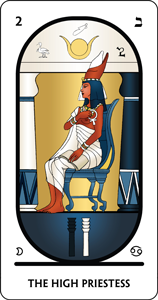
Maya represents the Second Arcanum: the Priestess, the Divine Mother, she who gives birth to the Gods. As you can see on the Tarot card, She sits in the temple, with the secret knowledge on her lap and the key to knowledge of Her grasped in her hand, symbolized by the Ankh—for She is the Mother, the Giver of Life—which is synonymous with the sign of Venus, the Goddess of love.
This initiatic story of divinity impregnating the Priestess is not unique to Buddhism. The same symbolism exists in the Egyptian tradition as Isis who gives birth to Horus, and it exists in the Christian tradition as well:
To a virgin espoused to a man whose name was Joseph, of the house of David; and the virgin’s name was Mary.
And the angel came in unto her, and said, Hail, thou that art highly favoured, the Lord is with thee: blessed art thou among women.
And when she saw him, she was troubled at his saying, and cast in her mind what manner of salutation this should be.
And the angel said unto her, Fear not, Mary: for thou hast found favour with God.
And, behold, thou shalt conceive in thy womb, and bring forth a son, and shalt call his name Jesus (“Savior”).
He shall be great, and shall be called the Son (Bodhisattva) of the Highest: and the Lord God shall give unto him the throne of his father David:
And he shall reign over the house of Jacob for ever; and of his kingdom there shall be no end.
Then said Mary unto the angel, How shall this be, seeing I know not a man (through carnal desire)?
And the angel answered and said unto her, The Holy Ghost shall come upon thee, and the power of the Highest shall overshadow thee: therefore also that holy thing which shall be born of thee shall be called the Son of God. - Luke 1:27-35
When we say Mary or Maya was a virgin, we mean in the esoteric sense. This indicates that she was pure, without defilement. Defilement relates to the mind and how we utilize energy. Someone who is corrupt with desire is impure. Those who have no desire are pure. A true virgin is someone who is undefiled: they are free of desire.
The word Maya literally means “appearance.” The way it is typically translated is as “illusion.” Westerners have misconstrued the meaning of this word Maya, as being something that is always negative, but it is not. Maya is the name of the Divine Mother, but the Divine Mother has many aspects.
When we look at the Arcanum Six, we see two women on either side of the initiate. These are two aspects of the Divine Mother: the pure and the impure. We see the pure Divine Mother, who is the truth, who is a virgin. Oppostie her is the Divine Mother Death, the Queen of the Abyss, who takes her children to the Second Death. She still loves her children, but she is a defiled mother; she is impure because her children are impure.
These are the two feminine principles of the universe, the Virgin and the Harlot, the Divine Mother or White Moon and Astaroth, Kali, or Black Moon, which refers to its tenebrous aspect. - Samael Aun Weor, Tarot and Kabbalah
Normally, when western scholars discuss Maya, they are discussing the impure mother, the mother of illusion, deception, and deceit. But be clear in your understanding of the word maya: it does not always mean something negative. The term Maya is actually a title for the wife of Shiva, who is also known as Shakti. Shiva could not exist without Maya, without his spouse. This combination of male-female (Shiva-Shakti, Yab-Yum) is the basis of existence (see page 16).
It is also interesting to note the word Maya is the name of an entire population in Latin America, and they worship the virigin Goddess Xquic:
When asked by her father who was responsible for her pregnancy Xquic replied, “There is no man whose face I’ve known… What’s in my belly generated all by itself when I went to marvel at the head of (the God) Hun Hunahpu…” - The Universal Savior
The mother of the Buddha is symbolic of the pure state of consciousness required in order for the Buddha to be born within us. If we remain defiled by desire, then we are slaves of the Whore; therefore, the Buddhic consciousness is out of reach. It cannot manifest.
In the Kabbalistic Tarot, Arcanum One is the Magician, which symbolizes the Spirit: the Contemplation Buddha. Arcanum Two is the Priestess, and symbolizes matter, or the vehicle through which the Spirit can act. If the matter is impure, corrupted with desire, then the Spirit cannot use it.
The white elephant symbolizes the pure, robust intelligence of the Spirit, who descends into the womb of the Divine Mother Maya at a time when her husband cannot touch her: in other words, at a time and place where there is no desire. Therefore, Maya is virginal: she is uncorrupted, pure, just like Mary, the mother of Jesus.
The number one, the Father who is in secret, is the Eternal Masculine Principle. He is within Himself Brahma, who has no form, is impersonal and ineffable, and who can be symbolized by the sun. The number two is the Divine Mother. She is the Eternal Feminine Principle that can be symbolized by the moon. Brahma has no form, He is what He is. But, in Himself, He is the governor of the universe. He is Ishvara, the Eternal Masculine Principle, the Universal Principle of life.
The Universal Principle of life unfolds in the Eternal Feminine Universal Principle, which is the Great Pralaya of the universe, of the cosmos, Her fertile bosom where everything is born and where everything returns. - Samael Aun Weor, Tarot and Kabbalah
The combination of these two results in the creation of existence, which is Arcanum 3.
Third Great Deed: Birth
In the Kabbalistic Tarot, the Second and Third Arcana both represent aspects of the Divine Mother. The Third Arcanum is related to how the Divine Mother manifests, produces, creates. The number 3—the trinity—is the law of creation.
Many of the fundamental aspects of the Path are described in threes:
- Three Jewels: the Buddha, Dharma and Sangha
- Three Paths: Shravakayana, Pratyekayana, Bodhisattvayana
- Body, speech, and mind
- The Trikaya
- Three baskets of teachings (Tripitaka)
There are too many examples to list here! The point is that three factors create.
To reach any goal, you always need three factors. One way to look at this is that the first factor is the intention or projective force towards that goal, the second factor opposes it (resistance), and the third conciliates them. These three factors are easily visible in electricity.
The most striking example of the three forces is found in the relationship between man and woman. As duality, they conflict; one is always trying to overcome the other. If you add sex to the equation as a third force, then there is a lot of energy and creation can occur. Balance and creation can then be established: but only if the energy is properly managed. This is so because the third force is both creative and destructive. If the couple does not manage sex in a healthy way, then sex destroys the relationship.
We can see the forces of these three factors clearly in the stages we have studied so far:
- First Great Deed: The intention to help suffering beings (projective force)
- Second Great Deed: The Divine Mother is impregnated (receptive force)
- Third Great Deed: The Buddha is born (the first two factors are equilibriated and realized)
So in the Third Stage of the Buddha’s initiatic story, he is born. This is symbolic of many things.
First, a Buddha is born of sex—not lustful sex, but another kind of sex, something divine, pure, and holy.
Second, a Buddha is born of a pure, divine woman: the Goddess. We each have our own inner Divine Mother, and she can give birth to our own inner Buddha, if we satisfy the requirements. That is: the right factors need to be brought together. If they are, then the Buddha can be gestated and born.
The Third Arcanum is the fecundated mother, ready to give birth to her sacred son. She is Isis, Mary, Hera, Shakti: the mother of the Gods.
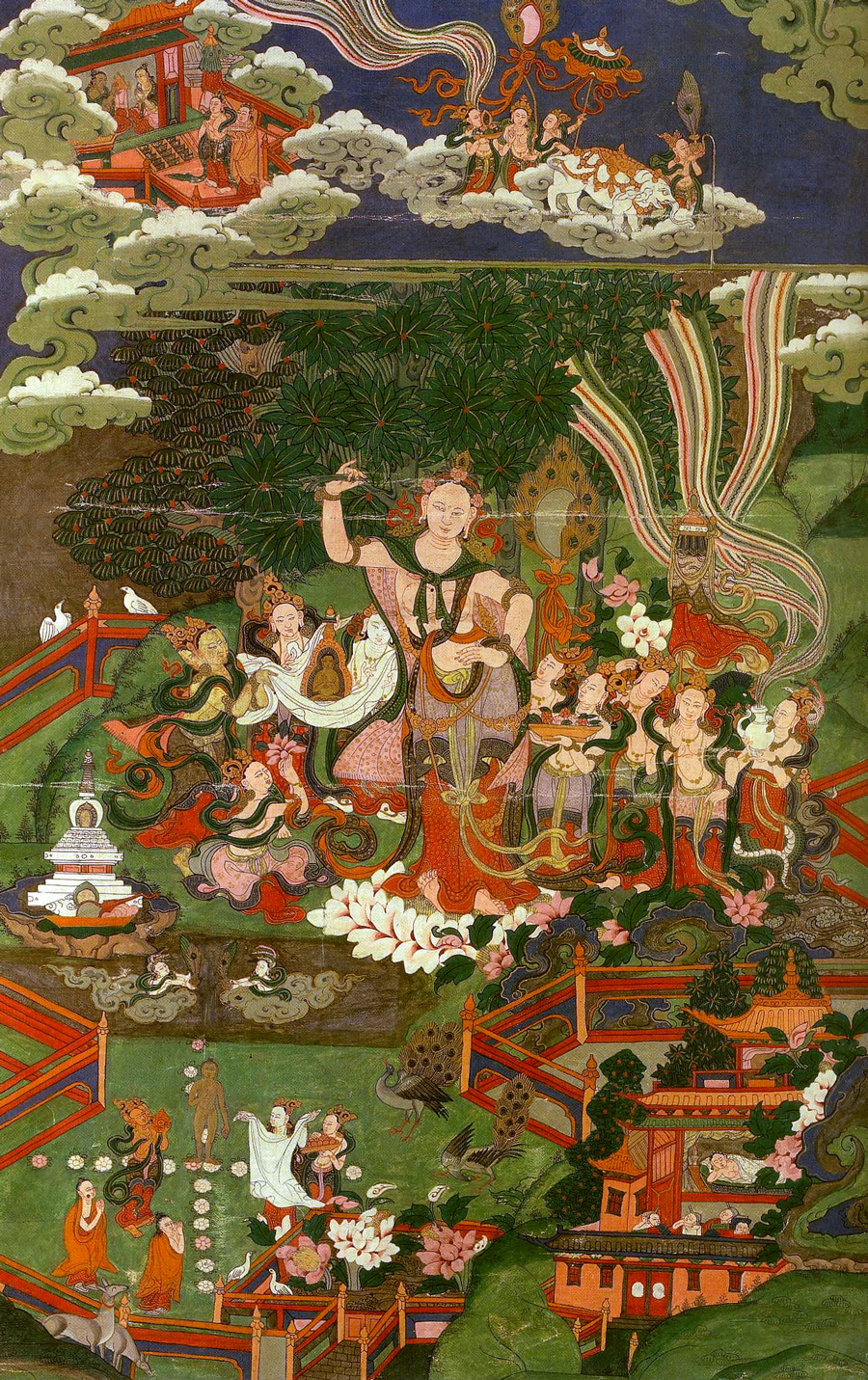
Queen Mahamaya Grasps the Tree of Life
Then one day by the king’s permission the queen, having a great longing in her mind, went with the inmates of the gynaeceum into the garden Lumbinî.
As the queen supported herself by a bough which hung laden with a weight of flowers, the Bodhisattva suddenly came forth, cleaving open her womb.
At that time the constellation Pushya was auspicious, and from the side of the queen, who was purified by her vow, her son was born for the welfare of the world, without pain and without illness.
Like the sun bursting from a cloud in the morning,--so he too, when he was born from his mother’s womb, made the world bright like gold, bursting forth with his rays which dispelled the darkness.
As soon as he was born the thousand-eyed (Indra) well-pleased took him gently, bright like a golden pillar; and two pure streams of water fell down from heaven upon his head with piles of Mandâra flowers. - Buddhacarita of Ashvaghosha, I.23-27
In order to steady herself, she reached up with her right hand and grabbed the tree. At that moment, the Buddha emerged from her right side. She gave birth through her side. This is a kabbalistic, initiatic symbol.
Firstly, she grabs onto the tree: a symbol of the Tree of Life. She grasps onto it to give her a foundation, stability, strength, support. The Tree of Life in us is our spinal column, through which the Kundalini rises. The Tree of Life is also the consciousness, the Being. In order for the inner Buddha to be born, we need to awaken consciousness and have our center of gravity be firmly in our own internal Tree of Life.
Traditionally, the tree is said to be a Plaksha tree (Ficus infectoria), which is a form of fig tree. In various Hindu scriptures, the Plaksha tree is associated with the Sarasvati river. Sarasvati is a name of the Divine Mother. The Plaksha is a close relative of the Bodhi tree (Ficus religiosa), which we will encounter later in the story. But both trees are very important: they are both variations of fig tree, which are closely related with sexuality.
But his delight is in the law of the LORD; and in his law doth he meditate day and night. And he shall be like a tree planted by the rivers of water, that bringeth forth his fruit in his season; his leaf also shall not wither; and whatsoever he doeth shall prosper. The ungodly are not so: but are like the chaff which the wind driveth away. - Psalm 1:2-4
In other words, if we know and respect the laws of the consciousness, we can awaken and grow like a fig tree planted by the rivers of Sarasvati, the Divine Mother. But as the fig tree symbolizes, Right Action is rooted in sexuality.
The fig tree symbolizes the feminine sexual forces that we must learn how to control. - Samael Aun Weor, Igneous Rose
Even so every good tree bringeth forth good fruit; but a corrupt tree bringeth forth evil fruit.
A good tree cannot bring forth evil fruit, neither can a corrupt tree bring forth good fruit.
Every tree that bringeth not forth good fruit is hewn down, and cast into the fire. - Matthew 7:17-19
Mahamaya steadies herself with her right hand, which in Asian culture symbolizes pure action. The left hard is related with impurity and harmful action. By using only her right hand, she demonstrates that she knows how to control the forces of the fig tree in a pure way: the sexual forces. Because of this, she is capable of being a channel for the arrival of the Buddha. If she did not have this kind of control over her own sexual forces, she would not be able to receive and deliver the cosmic power of the Buddha.
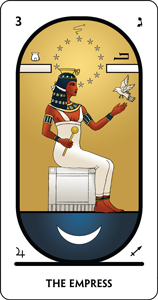
In the Tarot, the Empress holds a wand of power in her right hand, which represents the same thing: power is in the Law of Three—which we all have, in accordance with our Level of Being—and if we use it well, then good things can come of it. But if we abuse our power—the most awesome of which is sexual—then we acquire karma and suffering.
In this case, Mahamaya represents to us that by using our sexual power well (by relying on the relationship between pure action and the Tree of Life) the Buddha can be born inside of us.
From her right side emerges this child, the Buddha. This relates very well to Adam and Eve. In the Judeo-Christian book of Genesis (Bereshit), Eve is pulled from the right side of Adam, and this is symbolic of how the soul unfolds and manifests, how the Tree of Life unfolds itself in levels in order to create existence.
Present at the birth of the Buddha were many of the Hindu Gods, such as Indra, Brahma, and many others. If you see paintings of the moment of his birth, you will see Gods there assisting, receiving the child, bathing the child, holding parasols, and assisting the whole process. This is very unusual and needs to be understood.
In the Hindu tradition, cleanliness is very important, and because there is blood and fluid accompanying a typical birth, birth is said to be an unclean event, therefore the Gods are offended and will not come to such an event. In Gnosis we understand that, because the typical birth is a result of desire-based sexuality, so it is not an immaculate birth.
But in the case of the Buddha—just like Jesus—this was a birth that was clean, because the conception was from chaste sexuality—without animal desire, without orgasm—and that is why the Gods were there. The Gods were present at his birth because of the cleanliness of the event, because it happened without lustful desire. In other words, it was an event of chastity: pure, white tantra.
At the moment of his birth, many miracles happened in the region. There was a great rain, which ended some troubles for the local people, and there were many other births in the region: many children and many animals were born, both of which provide material gains. Therefore, the King named him Siddhartha, which means “accomplisher of aims,” or “fulfiller of wishes” someone who accomplishes what they set out to do, which in this case, is to serve all beings.
It is said that upon exiting the womb the Buddha child placed his feet on the ground, raised his finger to the sky, and exclaimed, “Look to me!” And he walked seven steps.
Unflurried, with the lotus-sign in high relief, far-striding, set down with a stamp,--seven such firm footsteps did he then take,--he who was like the constellation of the seven rishis. - Buddhacarita of Ashvaghosha, I.33
These seven steps are known to all the Freemasons in the world, for there are seven sacred steps to enter the temple. The seven steps represent seven great initiatic works that must be accomplished in order for the Buddha to incarnate inside of the soul. These seven steps are the Seven Initiations of Major Mysteries, which culminate in the completion of the creation of the solar vehicles, within which the Being—our inner Buddha—can perform his mission on Earth. Therefore, the Buddha takes these seven symbolic steps to demonstrate that he has accomplished this task, and others should so likewise.
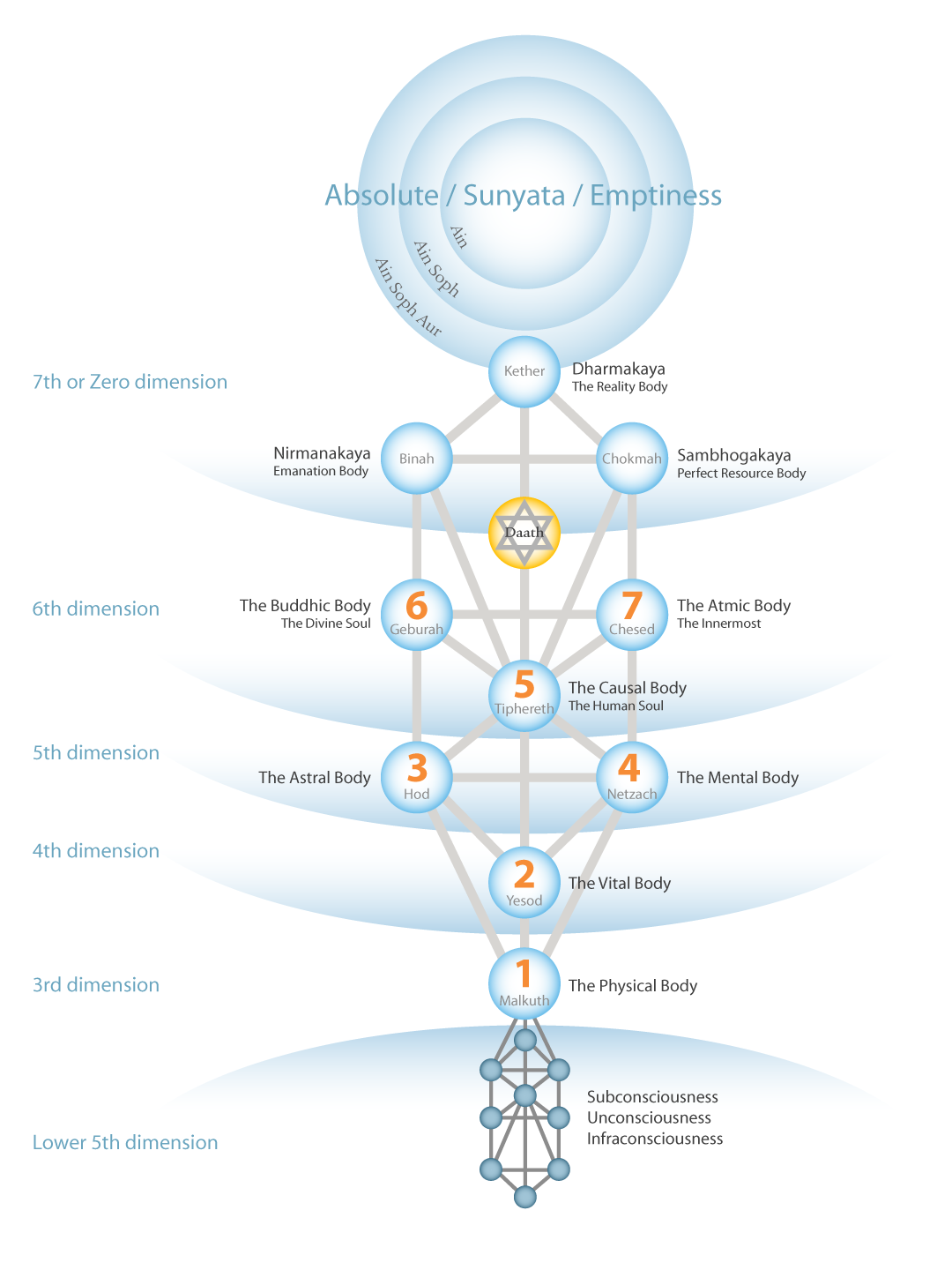
The Seven Initiations on the Tree of Life
He then exclaims, “I am the best in this world!” This is not pride: it is a statement of fact. The Buddha that is waiting to be born in us is absolute happiness, absolute peace, absolute love—there is nothing in the world that is greater than our own inner Buddha. But we have to work to give him a place to be born inside of us. As we are now, we are filthy with lust, pride, envy, and more. We have to clean our psychological temple, then the Buddha will come to be born there.
There are many great masters who were born of immaculate births. There is Buddha, Jupiter, Zeus, Apollo, Quetzalcoatl, Fuji, Lao-tse, Jesus—all were born of virgins, all born of an Immaculate Conception. Their mothers were virgin: virgin before, during, and after the childbirth.
When the Buddha-child was born, some sages, some educated priests, analyzed the child and discovered that he had all of the esoteric symbols, or signs, in his physical constitution, that demonstrated that he is a Buddha. There are many such symbolic signs.
Whosoever studies the thirty-two capital signs of Buddhahood biologically will reach the conclusion that the secondary sexual characteristics of Buddha were really those of a Super-Man. These secondary sexual characteristics of Buddha indicate, point to, a very intense sexual transmutation. There can be no doubt that Buddha practiced Maithuna, Sexual Yoga, Sexual Magic, the Arcanum A.Z.F. Buddha taught White Tantra (Sexual Magic); however, he taught these teachings in secrecy to his disciples. Zen and Chan Buddhism teach Maithuna and couples practice this Sexual Yoga. - Samael Aun Weor
According to a religious custom, newborn children were to be taken to the temples to pay homage to the Gods. So the royal couple took their new son, and the Shakya clan warriors were so awestruck by the radiance of the child that they bowed: thus he earned his name the “sage of the Shakya” —Shakyamuni.
Upon arriving at the temple, the parents were to help the child pay homage to the Gods. But when the Buddha-child was about the step into the temple door, the statue of the tribal deity (the divine spirit of the clan, or the Pennate God) came to life, bowed to the Buddha’s feet, and escorted him inside. When the Buddha’s right foot touched the temple floor, all the statues—Indra, Brahma, Surya, Vishnu, and more—came to life and bowed before the Buddha. The earth shook. At this incredible sight, the Buddha’s father gave him another name: Devatideva, “God of Gods.”
